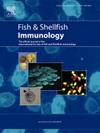Evaluating the effectiveness of an autogenous vaccine to prevent motile Aeromonas septicaemia in striped catfish (Pangasianodon hypophthalmus) formulated by using DNA fingerprints for bacterial inclusion
IF 4.1
2区 农林科学
Q1 FISHERIES
引用次数: 0
Abstract
Many Aeromonas species are infecting striped catfish in the Mekong Delta in Vietnam. This study aimed to evaluate the effectiveness of autogenous vaccines developed by analysing the genetic diversity through DNA fingerprint analysis. A total of 38 Aeromonas strains isolated from 2017 to 2022 were analysed for phenotypic differences using the repetitive element sequence PCR (rep-PCR) with the (GTG)5 single-primer. The vaccines were water-in-oil emulsion whole-cell inactivated with two monovalent vaccines containing antigens of Aeromonas VH31 (VC-VH31), or Aeromonas VH74 (VC-VH74) and a bivalent vaccine with both Aeromonas VH31 and VH74 (VC-VH31/74). The experiment lasted for 60 days in water at 28 °C and was performed in triplicates. Blood samples were taken at 0, 15, 30, 45 and 60 day post vaccination (dpv) to collect the serum. The challenge infection was performed as a co-infection immersion challenge of two homologous strains of Aeromonas VH31 and Aeromonas VH74 at dose LD60 value 0,55 × 107 cfu/mL and 0,47 × 108 cfu/mL, respectively. The highest relative percent of survival (RPS) of the VC-VH31/74 bivalent vaccine was 100 % and the fish displayed no clinical signs of disease. At 30 dpv, the concentration of total leukocytes, lymphocytes, monocytes and granulocytes was highest in the group receiving the dual vaccine. Additionally, the results showed that the difference between the vaccines was significant when ELISA analysis of IgM-specific antibodies in serum, and the result was highest in VC-VH31/74 bivalent vaccine after 30 days (p < 0.05) and remained stable until 60 dpv. The vaccine showed good immunogenicity and high protective efficacy against Aeromonas spp. in catfish. Thereby demonstrating the potential of Aeromonas autogenous vaccine use.
评估利用 DNA 指纹鉴定细菌包涵物配制的自体疫苗预防带鱼(Pangasianodon hypophthalmus)运动性气单胞菌败血症的效果。
越南湄公河三角洲的带鱼感染了许多种气单胞菌。本研究旨在通过 DNA 指纹分析法分析遗传多样性,从而评估自体疫苗的有效性。利用(GTG)5单引物的重复元件序列PCR(rep-PCR)分析了2017年至2022年分离的共38株气单胞菌的表型差异。疫苗为油包水乳剂全细胞灭活疫苗,其中有两种单价疫苗,分别含有气单胞菌 VH31(VC-VH31)或气单胞菌 VH74(VC-VH74)的抗原,以及一种含有气单胞菌 VH31 和 VH74 的双价疫苗(VC-VH31/74)。实验在 28 °C的水中持续 60 天,并以三份重复的方式进行。在接种后 0、15、30、45 和 60 天(dpv)采集血样以收集血清。对 VH31 和 VH74 两株同源的气单胞菌进行浸泡挑战感染,剂量 LD60 值分别为 0.55 × 107 cfu/mL 和 0.47 × 108 cfu/mL。VC-VH31/74 二价疫苗的最高相对存活率 (RPS) 为 100%,鱼类未出现任何临床疾病症状。30 dpv时,接种双价疫苗组的白细胞总数、淋巴细胞、单核细胞和粒细胞浓度最高。此外,在对血清中的 IgM 特异性抗体进行 ELISA 分析时,结果表明疫苗之间的差异显著,30 天后,VC-VH31/74 二价疫苗的结果最高(p<0.05)。
本文章由计算机程序翻译,如有差异,请以英文原文为准。
求助全文
约1分钟内获得全文
求助全文
来源期刊

Fish & shellfish immunology
农林科学-海洋与淡水生物学
CiteScore
7.50
自引率
19.10%
发文量
750
审稿时长
68 days
期刊介绍:
Fish and Shellfish Immunology rapidly publishes high-quality, peer-refereed contributions in the expanding fields of fish and shellfish immunology. It presents studies on the basic mechanisms of both the specific and non-specific defense systems, the cells, tissues, and humoral factors involved, their dependence on environmental and intrinsic factors, response to pathogens, response to vaccination, and applied studies on the development of specific vaccines for use in the aquaculture industry.
 求助内容:
求助内容: 应助结果提醒方式:
应助结果提醒方式:


